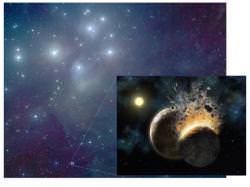As you gaze up at the familiar Pleiades star cluster, here’s something new you can think about. Planets recently collided around two of the stars in the cluster, kicking up vast clouds of dust. New worlds are being formed, and destroyed, right before our very eyes. At least, if you’ve got the help from some of the most powerful telescopes on Earth, and in space.
This announcement was made by a team of astronomers using the Gemini Observatory in Hawaii and the Spitzer Space Telescope. Their findings will be published in an upcoming issue of the Astrophysical Journal.
The Pleiades star cluster – located in the constellation Taurus – is one of the most famous objects in the night sky. Easily visible to the unaided eye, it’s even more spectacular in binoculars or a small telescope. Although it’s often referred to as the “seven sisters”, the cluster actually contains 1,400 stars, in various stages of formation.
One of the stars, known as HD 23514, has a little more mass than our Sun. The astronomers discovered that it’s surrounded by an enormous disk of hot dust particles. Astronomers think that this is the debris from a planetary collision.
It’s believed that these dust particles, the building blocks of planets, accumulate into comets and asteroid-size bodies and then clump together into larger and larger objects. This is a violent process, though. Some objects get bigger, and others collide, shattering into dust that astronomers can detect.
Astronomers think that this is a similar process that led to the formation of the Earth’s moon. At some point in the early Solar System, a Mars-sized object collided with the Earth. The debris from that collision became the Earth and the Moon.
Two stars in the Pleiades cluster, HD 23514 and BD +20 307, are thought to be in this stage of evolution. They’re between 100 and 400 million years old. Much younger stars can have this dust when they’re 10 million years old, but it’s usually dissipated by the time a star reaches 100 million years old. It takes enormous planetary collisions to get the dust spewing out again.
Original Source: UCLA News Release

